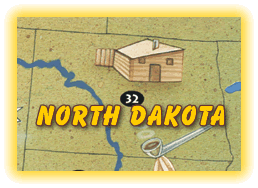
 Welcome to the real world. The Lewis & Clark Interpretive Center has been described as both exceptional and world-class. Overlooking the Upper Missouri River the Interpretive Center has displays and exhibits that make the Corps of Discovery’s journey seem very real. There is an enormous river canoe carved from the trunk of a cottonwood tree. It shows the extent of preparations made by the Corps members as they prepared for the next part of their journey. This museum is user-friendly and fun for all ages. (McLean County Highway 17, Washburn. 1(701) 462-8535 or www.fortmandan.com)
Welcome to the real world. The Lewis & Clark Interpretive Center has been described as both exceptional and world-class. Overlooking the Upper Missouri River the Interpretive Center has displays and exhibits that make the Corps of Discovery’s journey seem very real. There is an enormous river canoe carved from the trunk of a cottonwood tree. It shows the extent of preparations made by the Corps members as they prepared for the next part of their journey. This museum is user-friendly and fun for all ages. (McLean County Highway 17, Washburn. 1(701) 462-8535 or www.fortmandan.com)
Get the rest of the story at the fort. Located two miles west of the Lewis & Clark Interpretive Center is Fort Mandan. Also on the Upper Missouri River, it is near the site of the original 1804 winter quarters and the Mandan-Hidatsa Indian village. The now reconstructed Fort Mandan has full sized replicas of the original rooms built and used by the Expedition. They have created an inviting way to experience the past with interpreters providing year-round tours of Lewis & Clark’s 1804-1805 wintering post. Visitors may try on a bearskin while passing a peace pipe or enjoying frontier fiddle music. (McLean County Highway 17, Washburn. 1(701) 462-8535 or www.fortmandan.com)
There’s no place like home.The Knife River Indian Villages National Historic Site is located a half hour west of Lewis and Clark Interpretive Center. This location was once the home of Sacagawea and her husband Toussaint Charbonneau. The Museum has exhibits of North American Indian artifacts and crafts, an orientation film and a replica of a full-sized earth lodge. There are the remains of three village sites where one can see circular depressions, cache pits, fortification ditches, and travois trails. There are 13 miles of trails for hiking through natural areas and around the cultural sites. (Stanton. 1(701) 745-3300 or www.nps.gov/knri/index.htm)
© 2003 Travel Communications, Inc.
Content syndication services provided by TheFamilyTravelFiles.com
